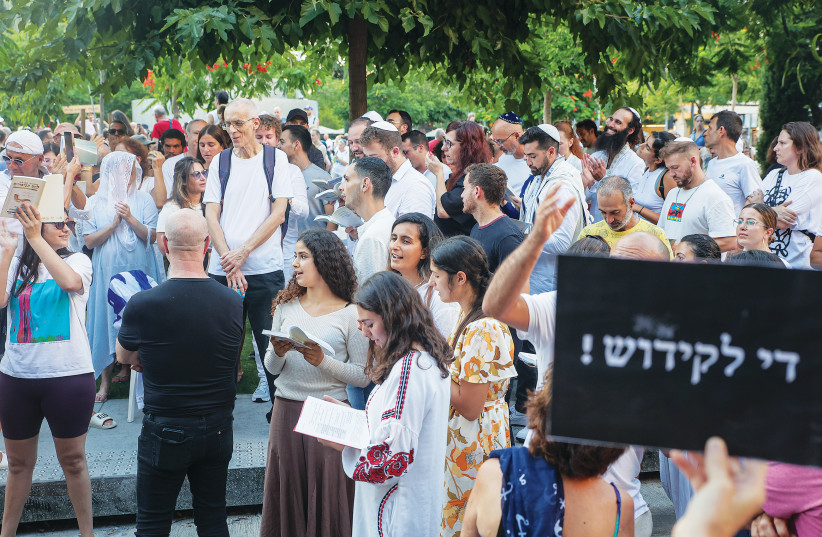The disturbing images of the scuffles that erupted on Yom Kippur Eve in Tel Aviv on September 24 keep replaying in my mind.
The gender partition set up by the Orthodox Rosh Yehudi organization during the Kol Nidre prayer in Dizengoff Square is a metaphor. The debate is not about a gender partition but rather about the separation fence that grows ever higher as certain divisive elements are seeking to create a barrier between Jewish Israel and democratic Israel for several years and particularly in the past nine months.
Normally, no one would disagree that every person, irrespective of their opinion, should have the right to in their own way, envelop themselves in sanctity on Judaism’s holiest day. But the reality here has long been far from normal.
These divisive forces call on everyone to choose a side without understanding that these two values live together and that without one or the other, the State of Israel loses the basis for its existence.
Should the citizens of Israel have to choose sides between being Jewish or democratic? Splitting a tallit (prayer shawl) whose ownership is disputed, is a familiar concept in Judaism. The good news is that we did not invent this dispute. The issue has always been the subject of controversy. The bad news is that the debate has reached boiling point and there is no leader to calm the situation. A fire is burning the prayer shawl.

The time to restore order has arrived
To do so, we must go back to basics. Let us start with the Jewish component: In the story of the creation of the world, it is written: “So, God created mankind in his image; in the image of God, he created them (Genesis 1:27).”
This one verse embodies an entire concept.
Unlike the stories of other ancient Middle Eastern nations, with their holy kings and idols, a basic principle of the Bible comes along and teaches us a key principle: Divinity exists in every human being. This approach results in a “democratic” perception of the dignity and rights of all people.
The idea of a Jewish state is mentioned in the UN General Assembly Resolution of November 29, 1947, and is subsequently anchored in Israel’s Declaration of Independence.
So where did the idea of a democratic state come from? While the Declaration of Independence does not explicitly mention the word “democracy,” it undoubtedly envisions Israel as a democracy, stating that the Jewish state will have elections, a constitution, institutions of governance, and a constituent assembly.
In its vision, the Declaration of Independence outlines both Jewish and democratic foundations. The State of Israel is a Jewish nation-state whose religion is Judaism. Can a nation-state also be a democratic state? Take the example of European countries: In Europe, the nation existed before the establishment of the modern state; these countries were established on the basis of an ethno-cultural identity.
As such, these Western countries each have their own nation, and they all respect the components of democracy. Having official state religions is no impediment to democracy. Britain, where the ruling religion is the Anglican Church, is an example of a democracy with a state religion, as are countries like Norway and Denmark that adopted both the Lutheran Christian religion and democratic values.
So why do many Israelis struggle to reconcile “Jewish” and “democratic” as parts of a single whole?
The answer is rooted in the political system and the power structure in Israel. Over the years, the democratic component has been eroded (elections alone are not democracy), while the Jewish component (as the state religion) has never been defined and has taken on shades that have nothing to do with Judaism.
The current government has taken things to a new level, and parts of the coalition are unaware that a messianic halachic state is not a Jewish state.
Returning to the harsh images of the eve of Yom Kippur, 2023. The fuel thrown onto the fire fanned the flames: Prime Minister Benjamin Netanyahu has divided the people into those who are “authentic” Jews and those who are not. The division serves him but does not serve us. If we manage to understand that this is not a political debate but a threat to our very basic existence here, we will conclude that there is no “Jewish” without “democratic,” and vice versa.
The fact of the matter is that the struggle for democratic Zionism will also affect Israel’s Judaism. The idea that power lies in the hands of one authority is not the way of Judaism; a state that is less democratic is also less Jewish.
As the late Israeli jurist Menachem Elon once put it: “The dual-purpose end – a Jewish and democratic state – is one, and one arrives and teaches about the other, and one arrives and completes the other, and they become one in our hands.”
The writer is a publishing expert at The MirYam Institute. She served as a Knesset member in the 24th Knesset, as well as the deputy head of the Kiryat Tivon Regional Council. She is a senior lecturer in academia and a journalist.
